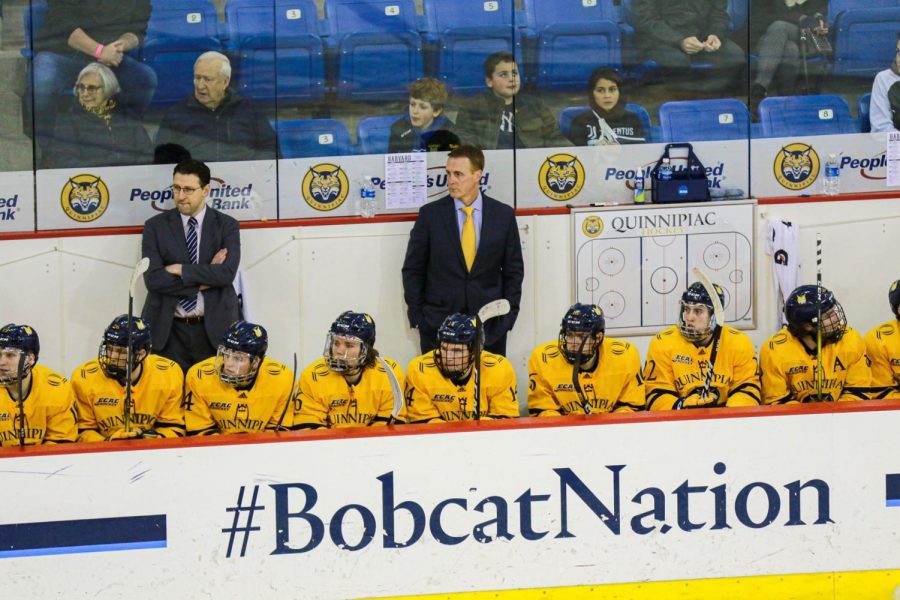Stock Up, Stock Down: Quinnipiac Men’s Ice Hockey Drops to 2-2 After Sweep
December 20, 2020
Highlights (Patrick Flatley Follow @_PatrickFlatley)
Film Room (Steven Pappas Follow @StevenPappas_23)
Story by Tom Krosnowski Follow @TKro42
Six days and four games into the Bobcats’ 2020-21 season, we’ve already learned quite a bit about the makeup of this Quinnipiac team.
The squad currently sits at 2-2 following Saturday’s backbreaking 4-2 loss to Bowling Green State University, and several players have stood out on both sides of the coin.
With four games in the books, let’s play “Stock Up, Stock Down” to assess which Bobcats players and units are trending in the right direction, and which need improvement.
Stock Up: New Kids
Some of the brightest individual performances from the Bobcats’ season have come from their new recruits. Five of the seven new Bobcats have played so far this year, and their presence has been felt.
Ty Smilanic makes things happen when he’s on the ice. His speed and stickhandling are a step above the rest at age 18, and it’s apparent why he was the highest draft pick in QU history.
Joey Cippolone, a valuable member of the University of Vermont Catamounts in 2018-19, had a number of chances coming off steals in the offensive zone. Christophe Fillion made his debut tonight, and showcased his speed drawing a penalty.
Nick Bochen’s laser is the best part of the otherwise-dormant power play and Iivari Räsänen has played in every game as a first-year defender.
The Bobcats lost a lot in Nick Jermain, Alex Whelan, and Karlis Cukste. However, this year’s class of new recruits looks like a keeper.
Stock Down: Returners
Before the season, head coach Rand Pecknold mentioned the importance of having a few of his returners stepping up and taking a leap forward. So far, that hasn’t come from enough of the sophomores and juniors.
Skyler Brind’Amour and TJ Friedmann are defensive-oriented centers, but only getting one point (a Brind’Amour assist) from the team’s second- and third-line pivots is not enough.
Meanwhile, wingers Michael Lombardi and Matthew Fawcett have been in and out of the lineup and Pecknold has had to shuffle his lines a few times.
Defensively, CJ McGee has stepped up in a big way, so he’s exempt, but Logan Britt got victimized on a Bowling Green rush on Friday and is still inconsistent.
Peter DiLiberatore, who is the most dynamic defenseman on the team, has undone his offensive effort by taking three penalties in four games, tied for the most on the team.
The Bobcats will need more from their returners if they’re going to compete for an NCAA Tournament berth. It’s only been four games, but by year’s end, it’s integral to see improvement from these classes.
Stock Up: Keith Petruzzelli
Last year, Petruzzelli was the Bobcats’ best player, providing a steady backstop while starting every game. Against Bowling Green, he was the reason the scoreboard wasn’t more lopsided.
Through four games, Petruzzelli has a 2.06 GAA and .927 SV%. Against Bowling Green, he saw 72 shots, an average of 36 per game.
Four of the five goals he let up were on the penalty kill, and the old saying that “your goalie has to be your best penalty killer” holds some weight, but he’s getting very little help at times (more on that below).
The goals he’s let up this season have included pucks that have gone off his own defenders’ legs, shots through heavy screens, and a play against Sacred Heart that could have been called back for goaltender interference. He got beat on the deciding goal on Saturday night, but few of the goals he’s let up have truly been his fault. There have also been a few lunging saves and hectic scrambles in front where Petruzzelli has stood tall.
Petruzzelli got a shoutout from his coach and his captain on Friday. Through four games, he’s been the same consistent player the team saw down the stretch last year, which is an encouraging sign.
Stock Down: Special Teams
Special teams might be the most concerning part of the Bobcats’ season so far. They were particularly poor against Bowling Green, giving up four power play goals and only scoring one in the two games.
The Bobcats’ Friday woes with the extra man were highlighted by their minute-long 4-on-3 power play, in which they didn’t generate any shots despite plenty of room to operate. Then, the Bobcats lost Saturday’s game on a power play goal that came just five seconds into the man disadvantage.
The worst thing for a struggling penalty kill is to keep committing penalties, and that’s doomed the Bobcats. After taking the fewest penalties in D-I program history last year, the Bobcats have averaged 5.3 penalties per game this season, which is far too many.
Although they’ve drawn a healthy average of six penalties per game, that doesn’t matter when the team is 1-for-its-last-17 on the man advantage.
The best way to fix special teams is to get back to the disciplined hockey that helped the team last year, and keep things simple on the power play. On Saturday’s game, the Bobcats were far more direct at getting the puck to the front of the net, rather than living on the perimeter and searching for the perfect pass, and it rewarded them with a goal.
Special teams units go through ebbs and flows, and it’s early in the season. But, the current state of the Bobcats’ special teams is a far cry from where it needs to be, and is a big area of improvement moving forward.








